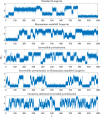Geometry-informed irreversible perturbations for accelerated convergence of Langevin dynamics
- PMID: 36156938
- PMCID: PMC9485103
- DOI: 10.1007/s11222-022-10147-6
Geometry-informed irreversible perturbations for accelerated convergence of Langevin dynamics
Abstract
We introduce a novel geometry-informed irreversible perturbation that accelerates convergence of the Langevin algorithm for Bayesian computation. It is well documented that there exist perturbations to the Langevin dynamics that preserve its invariant measure while accelerating its convergence. Irreversible perturbations and reversible perturbations (such as Riemannian manifold Langevin dynamics (RMLD)) have separately been shown to improve the performance of Langevin samplers. We consider these two perturbations simultaneously by presenting a novel form of irreversible perturbation for RMLD that is informed by the underlying geometry. Through numerical examples, we show that this new irreversible perturbation can improve estimation performance over irreversible perturbations that do not take the geometry into account. Moreover we demonstrate that irreversible perturbations generally can be implemented in conjunction with the stochastic gradient version of the Langevin algorithm. Lastly, while continuous-time irreversible perturbations cannot impair the performance of a Langevin estimator, the situation can sometimes be more complicated when discretization is considered. To this end, we describe a discrete-time example in which irreversibility increases both the bias and variance of the resulting estimator.
Keywords: Bayesian computation; Geometry-informed irreversibility; Monte Carlo sampling; Riemannian manifold Langevin dynamics; Stochastic gradient Langevin dynamics.
© The Author(s) 2022.
Conflict of interest statement
Conflicts of interestNot applicable.
Figures
















References
-
- Amari, Shun-ichi, Cichocki, Andrzej, Yang, Howard Hua: A new learning algorithm for blind signal separation. In: Advances in Neural Information Processing Systems, pages 757–763. Morgan Kaufmann Publishers, (1996)
-
- Asmussen Søren, Glynn Peter W. Stochastic simulation: algorithms and analysis. Germany: Springer Science & Business Media; 2007.
-
- Bierkens Joris. Non-reversible Metropolis-Hastings. Stat. Comput. 2016;26:1213–1228. doi: 10.1007/s11222-015-9598-x. - DOI
-
- Brosse, Nicolas, Durmus, Alain, Moulines, Éric: The promises and pitfalls of stochastic gradient Langevin dynamics. In: NeurIPS 2018 (Advances in Neural Information Processing Systems 2018), (2018)
-
- Diaconis P, Holmes S, Neal R. Analysis of a nonreversible Markov chain sampler. Ann. Appl. Probab. 2010;10:726–752.
LinkOut - more resources
Full Text Sources
